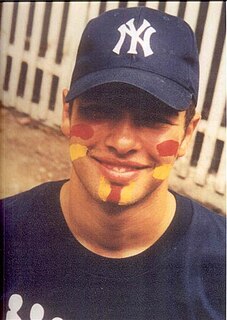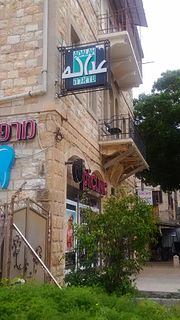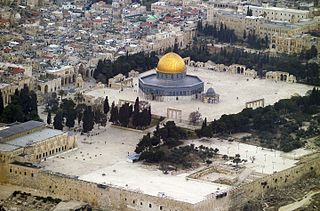The Or Commission, fully the Commission of Inquiry into the Clashes Between Security Forces and Israeli Citizens in October 2000, was a panel of inquiry appointed by the Israeli government to investigate the events of October 2000 at the beginning of the Second Intifada in which 12 Arab citizens of Israel and one Palestinian were killed by Israeli police amid several demonstrations. One Israeli Jew was killed by a stone dropped from a bridge onto her vehicle near one such demonstration; however, it is not clear that the incident was linked. The commission released its findings on "the clashes between security forces and Israeli civilians" on September 2, 2003. The chief investigator was Theodor Or, an Israeli Supreme Court Justice.

Umm al-Fahm is a city located 20 kilometres northwest of Jenin in the Haifa District of Israel. In 2019 its population was 56,109, nearly all of whom are Arab citizens of Israel. The city is situated on the Umm al-Fahm mountain ridge, the highest point of which is Mount Iskander, overlooking Wadi Ara. Umm al-Fahm is the social, cultural and economic center for residents of the Wadi Ara and Triangle regions.

The Maxim restaurant suicide bombing was a suicide bombing which occurred on October 4, 2003 in the beachfront "Maxim" restaurant in Haifa, Israel. Twenty-one people were killed in the attack and 60 were injured. Among the victims were two families and four children, including a two-month-old baby.

Land Day, March 30, is a day of commemoration for Arab citizens of Israel and Palestinians of the events of that date in 1976 in Israel.
Abnaa el-Balad is a secular Arab nationalist movement made up of Palestinians, most of whom are Arab citizens of Israel. The stated goals of the movement are: the return of all Palestinian refugees, an end to Israeli's occupation of territories and the establishment of a democratic, secular Palestinian state.

The Triangle, formerly referred to as the Little Triangle, is a concentration of Israeli Arab towns and villages adjacent to the Green Line, located in the eastern Sharon plain among the Samarian foothills; this area is located within the easternmost boundaries of both the Central District and Haifa District. The eleven towns are home to approximately 250,000 Arab citizens of Israel, representing between 10-15% of Israel's Palestinian Arab population.

Sheikh Raed Salah Abu Shakra is a Palestinian-Israeli religious leader from Umm al-Fahm, Israel. He is the leader of the Northern Branch of the Islamic Movement in Israel. He became the mayor of Umm al-Fahm in 1989 but stepped down in 2001 to focus on his religious activities. He has eight children, and is a former poet.

The death of Asel Asleh occurred on 2 October 2000 when an Israeli-Arab and peace activist was killed at the onset of the Second Intifada by the Israel security forces. Asleh was 17 years old at the time of his death.
In 2009, clashes between Muslim Palestinians and Israeli police erupted on September 27, 2009, and continued to late October. Violence spread through East Jerusalem and parts of the West Bank, and included throwing of Molotov cocktails and stones at Israeli security forces and civilians. Israeli police responded with arrests of rioters and sporadic age-based restriction of access to the Temple Mount. Several dozen rioters, police and Israeli civilians have been injured.
Racism in Israel encompasses all forms and manifestations of racism experienced in Israel, irrespective of the colour or creed of the perpetrator and victim, or their citizenship, residency, or visitor status.

The Camp 80 junction bus 823 attack was a suicide bombing on November 29, 2001, on an Egged bus in northern Israel. The bus, en route from Nazareth to Tel Aviv, was traveling through the town of Pardes Hanna-Karkur. Three passengers were killed in the attack and nine were injured.

Adalah – The Legal Center for Arab Minority Rights in Israel is a human rights organization and legal center.

Palestinian stone-throwing refers to a Palestinian practice of throwing stones at people or property. It is a tactic with both a symbolic and military dimension when used against heavily armed troops. Proponents, sympathizers, as well as analysts have characterized stone throwing by Palestinians as a form of "limited", "restrained", "non-lethal" violence. The majority of Palestinian youths engaged in the practice appear to regard it as symbolic and non-violent, given the disparity in power and equipment between the Israeli forces and the Palestinian stone-throwers, with many considering it a method of deterring Israeli military forces and civilians from the occupation of Palestinian lands. The state of Israel considers the act to be criminal, on the grounds that it is potentially lethal. In some cases, Israelis have argued that it should be treated as a form of terrorism, or that, in terms of the psychology of those who hurl stones, even in defense or in protest, it is intrinsically aggressive.
This is a list of individual incidents and statistical breakdowns of incidents of violence between Israel and Palestinian dissident factions in 2014 as part of the Israeli–Palestinian conflict.
Jewish Israeli stone-throwing refers to criminal rock-throwing activity by Jewish Israelis in Mandatory Palestine, Israel, the West Bank, the Gaza Strip and Jerusalem. It includes material about internecine stone-throwing, in which Haredi Jews throw stones at other Jews as a protest against what they view as violations of religious laws concerning Shabbat, modest clothing for women and similar issues, and material about stone-throwing by extremists in the settler movement.

Israeli settler violence refers to acts of violence committed by Jewish Israeli settlers and their supporters against Palestinians and Israeli security forces, predominantly in the West Bank. In November 2021, Defense Minister Benny Gantz discussed the steep rise in the number of incidents between settlers and Palestinians in the West Bank, many of which result from attacks by residents of illegal settler outposts on Palestinians from neighboring villages.
On 14 July 2017, three Arab-Israeli men left the Temple Mount, and opened fire on Israeli border police officers stationed near the Gate of the Tribes which is close to the Lions' Gate. Two Israeli border police officers were killed and two more were injured in the attack. All three attackers were shot and killed by Israeli police after fleeing back into the complex.

The 2017 Temple Mount crisis was a period of violent tensions related to the Temple Mount, which began on 14 July 2017, after a shooting incident in the complex in which Palestinian gunmen killed two Israeli police officers. Following the attack, Israeli authorities installed metal detectors at the entrance to the Mount in a step that caused large Palestinian protests and was severely criticized by Palestinian leaders, the Arab League, and other Muslim leaders, on the basis that it constituted a change in the "status quo" of the Temple Mount entry restrictions.

On 15 April 2022, clashes erupted between Palestinians and Israeli Security Forces on the Al-Aqsa Compound in the Old City of Jerusalem. According to the United Nations Special Coordinator for the Middle East Peace Process, the clashes began when Palestinians threw stones, firecrackers, and other heavy objects at Israeli police officers. The policemen used tear gas shells, stun grenades and police batons against the Palestinians. Some Palestinians afterwards barricaded themselves inside the Al-Aqsa Mosque and proceeded to throw stones at the officers. In response, police raided the mosque, arresting those who had barricaded themselves inside. In addition, some damage was done to the mosque's structure.













